
- MILL HILL
- WILDLIFE REPORTS 2011

Autumn Downland
Butterflies (August):
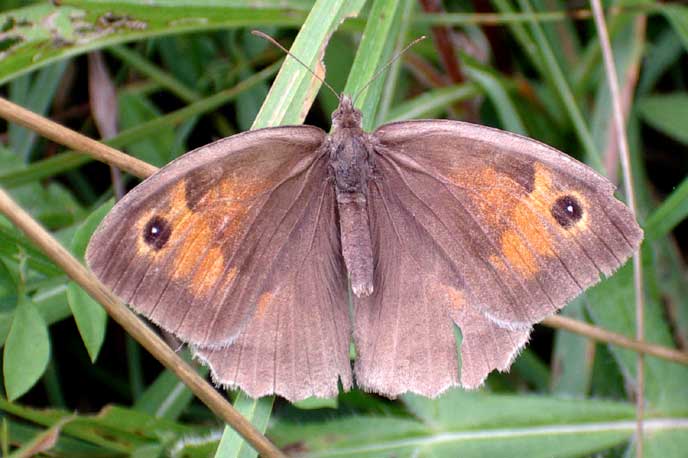 |
 |
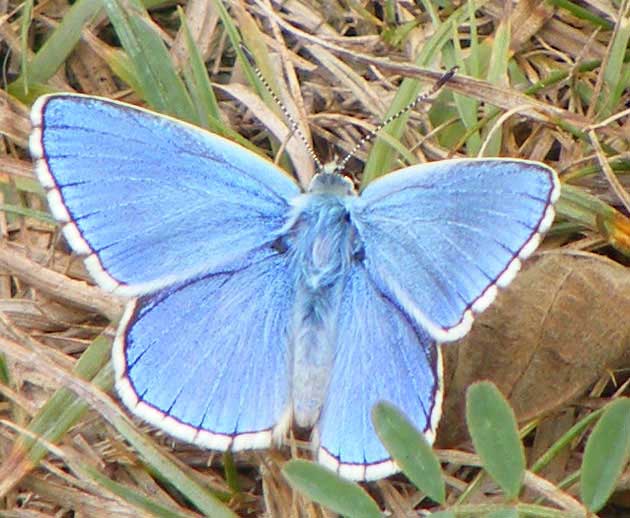 |
 |
|
|
|
|
|
Noticeable
summer plants of the upper meadows include Greater
Knapweed, Hardheads (=Lesser Knapweed),
Field
Scabious, Meadow Cranesbill, Alexanders,
Pyramidal
Orchids, Plantains,
Melilots,
Meadow Vetchling, Yarrow,
Eyebrights,
Musk
Thistles,
Hounds-tongue*,
Perforate
St. John's Wort*, Great Mullein* and
many others. Herb Robert is
found amongst the scrub.
(*notably
on disturbed ground.)
Some
Indicator Plants of Ancient Downland (Link)
Wild
Flora and Fauna on Chalk flickr
Adur
Wild Flowers 2009
| OVERVIEW:
A large part (724 acres) of the downs including Mill Hill were presented to the people of Shoreham in 1937. Just over 30 acres still remain as public open land and a Local Nature Reserve. This is divided into about 11 acres of grassland and meadows above the ridge, about 9 acres of scrub, the copse and glades at the northern end, and about half of the prime Chalkhill Blue area of 6.4 acres of herbland remaining. 6 acres has been lost to a Sycamore woodland on the southern slopes. This is low fertility chalkland not suitable for grazing. The top area is effectively a wild meadow and the lower slopes a rabbit warren dominated by prostrate (not the upright form) Horseshoe Vetch, Hippocrepis comosa. |

Horseshoe Vetch |
||||||||
| Chalkhill Blues:
Mill
Hill is nationally important because of its population of Chalkhill
Blue Butterflies. Estimates of the numbers
are notoriously inaccurate. In the 1950s
the population was estimated by R. M. Craske
to
be 50,000. This may be an exceptionally good year. I would estimate the
numbers at that time to be nearer 25,000 for Mill Hill only. After the
cattle grazing and thorn incursions the numbers plummeted to the most reliable
estimate in 1960
of 6,000. The new road and Sycamore woodland further denuded the Horseshoe
Vetch, Hippocrepis comosa,
and bare chalk downland to a figure I have estimated at a top figure of
3,000 Chalkhill Blue Butterflies at the turn of the millennium (counted
in 2003). Almost
all these butterflies are now to be found on the six acres of the lower
slopes.
|

 |
||||||||
| "Our
family lived at The Mill House, Mill Hill, from around 1933
until about 1967, and every July we saw the
"Butterfly Men" walking past onto the Downs. My father used to tell
us that they were interested in the blue butterflies."
Heather
Clark (née Eager), Ryde, Isle of Wight
|
Nearest
Postcode: BN43 5FH
Grid Ref: TQ 210 074 (upper car park) Geographic Link OS Map Google Earth Map Magic Map of Mill Hill NR Local Nature Reserve Designation Natural England: Local Nature Reserves Multi-Map (Bird's Eye View) |
FEATURE:
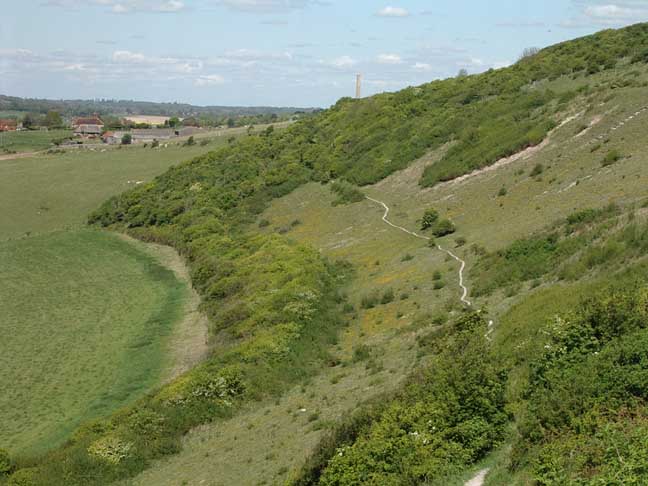
 |
Mill Hill Nature Reserve The butterfly lower slopes at Mill Hill are under serious threat by a natural process known as ecological succession where the woody shrubs like Privet, Brambles and Hawthorn invade the herb-rich slopes gradually turning the downs into woodland and eliminating the butterfly larval food plants especially the Horseshoe Vetch, Hippocrepis comosa, on which the Chalkhill Blue Butterflies rely. The remedy is by expert professional removal of the Privet on a regular basis. This job is now being undertaken by volunteers.
|

 |
WILDLIFE
REPORTS
Mill
Hill Wildlife Reports 2012 (Link)
25
November 2011
I
was delighted to see an Adder
slither off at the western end of the lower slope of Mill
Hill around noon.
It had been sunning itself in exactly the same place where I saw one in
September
2010. The spot gets the late Autumn sun
and is next to scrub for cover.
15
November 2011
On
the lower slopes (sheltered from the chill east wind) there was scarcely
anything to note: a half a dozen healthy Rabbits
were feeding in the open near the incursing Privet,
two White Dapperling,
Leucoagaricus
leucothites, Mushrooms
were seen in the central area below the path,
and a Red Admiral Butterfly fluttered
north to south. I
spotted a Common
Ink Cap Mushroom amongst
the tall sward south of the Reservoir, where a solitary Greater
Knapweed was still in flower.
A Kestrel
dived
into a Hawthorn
and disturbed some small birds, but flew off with empty talons.
 |
4
November 2011
The "Natural History of Mill Hill" Illustrated Talk by Andy Horton Shoreham Horticultural & Allotment Society St. Peter's Church Hall (entrance in West Street) 7:30 pm - 10:00 pm |
1 November
2011
 The
work of the conservation workers on Mill Hill is appreciated as they were
burning cut Privet
at the foot of the lower slopes. I am still dismayed that there is no consultation
with the public, as amongst all the scrubby thorn bushes a pair of attractive
Hawthorns
have been felled, ones that looked particularly good in their spring May
blossom. The only butterfly seen on Mill
Hill was a Red Admiral
under the Copse at the top. On the lower
slopes the only flowers noted were Autumnal
Hawkbit, Carline Thistle (including new
buds), Centaury
and a solitary Milkwort.
The
work of the conservation workers on Mill Hill is appreciated as they were
burning cut Privet
at the foot of the lower slopes. I am still dismayed that there is no consultation
with the public, as amongst all the scrubby thorn bushes a pair of attractive
Hawthorns
have been felled, ones that looked particularly good in their spring May
blossom. The only butterfly seen on Mill
Hill was a Red Admiral
under the Copse at the top. On the lower
slopes the only flowers noted were Autumnal
Hawkbit, Carline Thistle (including new
buds), Centaury
and a solitary Milkwort.
23
October 2011
On
a dry, breezy overcast (Cumulus > Cirrocumulus)
midday,
three languid Meadow
Brown
Butterflies
searched
out nectar plants on the lower slopes of Mill Hill, one frequently returning
to the one remaining Wild Basil
seen. A Common Darter
(dragonfly)
landed. On the lower slopes, Hawkbits
were still flowering with a few Yellow
Worts, some flowers still open in the
early afternoon. On the middle slopes, a Red
Admiral landed on the path immediately
south of the Copse on the top of the hill.
On the middle part of Mill Hill new buds of Carline
Thistle were emerging in the same photo
frame as older plants with copper and silver leaves. A Small Scabious
seed head was noted by the gate in the north-west.
 |
The Conservation Team had mown stretches of the southern area and middle slopes, notably the Triangle area and cleared the mixed patch of colonising flowers (Great Mullein, Musk Thistle etc.) on the lower slopes north of the path. This area was being surveyed by students at Brighton University. |
Red was thematic colour, the dark red of the Dogwood stems, the red berries of Hawthorn, Dog Rose, and a few Wayfaring Tree berries and the small Bittersweet. Sheep were grazing on the stumble of the hay meadow beneath Mill Hill.
17
October 2011
Spotting
a break in the clouds, I made a quick visit to Mill Hill in the afternoon,
where a Red Admiral Butterfly
left the shorn vegetation south of the Reservoir and another one was seen
blown about in the breeze over the Clematis-adorned scrub. Nectar plants
were now sparse on the lower slopes of Mill Hill with diminutive ground-hugging
Hardheads,
Stemless
Thistle and
Hawkbits
the most prevalent. Three Meadow
Browns
were disturbed in temperatures too cool for active butterflies
and then the darker clouds came over and I hurried home after the first
few spots of rain. A Common Darter
(dragonfly)
flew at head level. A flock of Rooks
soared on the thermals, but on the ground
the corvids were
Crows
and Magpies.
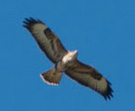 16
October 2011
16
October 2011
I
visited Mill Hill again hoping the Clouded
Yellow would still be around. No sightings
but there were some Brown Argus,
Meadow
Browns
and Common Blues.
15
October 2011
The
first absolutely positive Clouded Yellow
Butterfly of the year in the Adur
area was seen on Mill Hill and photographed visiting a Hawkbit.
It was a bit tatty, but it was my first of the year and made my day! There
were also some Common Blues, Meadow
Browns
and a Red Admiral.
A Buzzard
(photographed on the left by Colin Knight)
soared overhead.
9 October
2011
A
Kestrel
hovered over the middle slopes and thorn on Mill Hill. Wasps
dominated the Ivy hedge that bordered Mill Hill Road north of the bridge
over the A27.
So much so, that I did not expect any butterflies
on Mill Hill, until I immediately stumbled across a Speckled
Wood followed a few seconds later by a
Red
Admiral, both south of the Reservoir.
Eight Meadow
Browns
were
seen all on the lower slopes and two of them in flight and copulating.
A single male Common Blue
was lively over the lower slopes and a Peacock
Butterfly was seen on the Triangle
part of the middle slopes. There was at least one grasshopper
seen amongst the herbs.
Carline
Thistle were
common on the lower slopes, with new shoots and budding flowers,
ageing heads with green turning copper prickly leaves, old plants with
yellow heads and silver leaves and dead grey plants. All the types were
to be found close together at the northern end of the lower slopes. There
were just a handful of Devil's Bit Scabious
noted in an area were berrying Privet
was beginning to dominate. The dried stalks of Ragwort
were noted as well as occasional flowering plants.
Adur
Butterfly & Moth List 2011
3 October
2011
Rooks
flew over Mill Hill in the hazy sunshine and were frequently seen feeding
on the empty pastures to the east of Mill Hill. Butterflies
seen were 16 Meadow
Browns
(11
on the lower slopes on the transect only 70%
completed in the energy sapping conditions,
19.6
°C, around midday)
on the open downs, and one Large White
on the lower slopes. A few Speckled Woods
were seen amongst the scrub and at least one Red
Admiral. Nectar plants visited by the
Meadow
Browns
were
the frequently seen Hardheads,
the less frequent Stemless Thistles,
the common Hawkbits
and one of the two Devil's Bit Scabious
noted (list in order of preference, most visited
listed first). Carline
Thistle were common with most of them
with copper-coloured leaves already, but there were some budding all over
green new plants. They were not seen visited by any of the butterflies.
A Silver Y Moth
fluttered amongst the remains of the meadow flowers
south of the Reservoir.
Adur
Butterfly & Moth List 2011
28
September 2011
On
a (>20.6 °C) sunny
day, the frequent butterflies
were in the shade, at least 25 Speckled
Woods fluttered amongst the scrub on Mill
Hill. The weather was warm enough but the the count was a mere eleven
Meadow
Browns
(eight
on the lower slopes), at least two Small
Heath Butterflies (on the lower slopes),
one Brimstone Butterfly,
a few Large Whites,
Red
Admirals on the Ivy and Speckled
Woods anywhere shady. A passage walk over
the open top part of the hill did not reveal any butterflies just after
midday.
A Buzzard
soared in the azure blue cloudless sky
over the downs between New Erringham and Truleigh
Hill.
16
September 2011
 A
Jay
swooped down over the southern end of the lower slopes of Mill Hill, the
very first time I had seen this bird on the Mill
Hill Nature Reserve. The flowers
on Mill Hill were swayed in the Gentle Breeze
(Force 3)
from the south-east. At first there were hardly any butterflies
on the lower slopes but after about four minutes, the first of an estimated
60 Meadow
Browns
(about
35 on the lower slopes) appeared with a few couples mating (Meadow
Browns
tend to fly off even if copulating), an estimated 12 Small
Heaths (10 on the lower slopes) and two
male Common Blues.
Stemless
Thistle, Hardheads and Devil's
Bit Scabious were the most visited flowers
for nectar. Round-headed Rampion was
noted on a few occasions on the lower slopes. The Hawthorn scrub hosted
frequent
Meadow
Browns,
three Comma and
a few Red Admirals (both
on the Ivy near the NW gate), plus at least one Speckled
Wood. The
Triangle
area of the middle slopes hosted more Meadow
Browns
and just the one flighty Small Copper.
The Small Copper
visited Plantain,
the red leaves of Dogwood,
Perforate
St. Johns Wort, Sow
Thistle (in seed), Wild
Carrot and Hardheads,
resting briefly on the top of the plants before fluttering off. A handful
of Common Darters
(dragonfly)
flew rapidly overhead with none of them showing any signs of settling.
A
Jay
swooped down over the southern end of the lower slopes of Mill Hill, the
very first time I had seen this bird on the Mill
Hill Nature Reserve. The flowers
on Mill Hill were swayed in the Gentle Breeze
(Force 3)
from the south-east. At first there were hardly any butterflies
on the lower slopes but after about four minutes, the first of an estimated
60 Meadow
Browns
(about
35 on the lower slopes) appeared with a few couples mating (Meadow
Browns
tend to fly off even if copulating), an estimated 12 Small
Heaths (10 on the lower slopes) and two
male Common Blues.
Stemless
Thistle, Hardheads and Devil's
Bit Scabious were the most visited flowers
for nectar. Round-headed Rampion was
noted on a few occasions on the lower slopes. The Hawthorn scrub hosted
frequent
Meadow
Browns,
three Comma and
a few Red Admirals (both
on the Ivy near the NW gate), plus at least one Speckled
Wood. The
Triangle
area of the middle slopes hosted more Meadow
Browns
and just the one flighty Small Copper.
The Small Copper
visited Plantain,
the red leaves of Dogwood,
Perforate
St. Johns Wort, Sow
Thistle (in seed), Wild
Carrot and Hardheads,
resting briefly on the top of the plants before fluttering off. A handful
of Common Darters
(dragonfly)
flew rapidly overhead with none of them showing any signs of settling.
Full
Butterfly Report
 |
Two new White Dapperling, Leucoagaricus leucothites, mushrooms were spotted on the lower slopes by the scrubby hedgerow on the western edge. The first mushroom had a diameter of 35 mm and a height of 70 mm. |
11
September 2011
On
Mill Hill (lower slopes returning by the quickest ridge route) I recorded
60
Meadow
Browns
(48
on the lower slopes), ten male Adonis
Blues, ten Small
Heath Butterflies, four Large
Whites, one male and one female Common
Blue, and one Small
White. All species except the Meadow
Browns
were seen entirely in the one acre transect
area. Nectar plants were principally Stemless
Thistle with some butterflies
visiting Hardheads, Devil's
Bit Scabious, Hawkbits
and Carline Thistle.
The Hawkbit flowers
hosted small bees
(Lasioglossum,
most
likely Lasioglossum
calceatum) and
at least one small black pollen beetle
(probably Meligethes).
Full
Butterfly Report
10
September 2011
After
some poor weather, my weekly butterfly
transect on a cloudy dull day at Mill Hill
recorded five Adonis Blue,
two Chalkhill Blue,
52 Meadow
Browns,
one Small Copper,
and ten Small Heaths.
 |
 |
 |
 |
|
|
|
|
|
On the lower slopes Devils' Bit Scabious and Ploughman's Spikenard were noted in flower for the first time this year. Round-headed Rampion on the plateau was blowing about in the breeze making photography difficult even though it it did not impede my movement.
22
August 2011
Under
an overcast sky without the penetrating warmth of the sun's rays, nevertheless
it was a pleasant (18.6 °C SSE Force
2) autumn
midday, and on Mill Hill about 200 butterflies
fluttered around, 90% on the lower slopes. The complete count for Mill
Hill recorded an estimated 90+ Meadow
Browns,
a counted 19 Chalkhill Blues,
66 Adonis Blues
(including four females*), about 20 Common
Blues
(including about five females), an estimated
16+ Small Heaths,
one (perhaps the last of the year) faded but intact Gatekeeper,
one (possibly three) Brimstones,
a few Large Whites,
and a Speckled Wood
(in the scrub).
 |
 |
 |
 |
|
|
|
|
|
The
lower slope 1.2 acre transect
numbers were: 60+ Meadow
Browns,
a counted 19 Chalkhill Blues,
65 Adonis Blues
(including four females*), about 5 Common
Blues,
an
estimated 16+ Small Heaths,
one (perhaps the last of the year) faded but intact Gatekeeper,
one (possibly three) Brimstones,
and occasional faded pyralid
moths
Pyrausta purpuralis. *One faded
female could have been a Chalkhill Blue as its was visited very briefly
by a male.
The
female Adonis Blues
were mostly in very good condition.
The
Common
Blues
were
mostly scattered over the middle and upper meadows. There was breeze that
made photographing the butterflies on plantain
a little tricky as the long stems swayed. Meadow
Browns
on
the upper part of Mill Hill were the most prevalent butterfly with
over thirty seen. On the plateau just north of the Reservoir, a male Adonis
Blue was disturbed. All the suspected Brown
Argus turned out to be female
Common Blues when I looked at the spots on
the underside.
Brown
Argus and female Common Blues ID Images
On
the lower slopes, a few Round-headed Rampion
were
flowering
and there were more of these delicate blue flowers on the upper plateau.
The Adonis Blues
were noted visiting Squinancywort,
Hawkbits,
Carline
Thistle and Wild
Basil.
Umbellifers
19
August 2011
The
bottom of Mill Hill
was covered in Adonis Blues
and Meadow Browns. My transect count was 74 Adonis
Blues, 9 Chalkhill
Blue, 1 Common
Blue, 16 Gatekeeper,
68 Meadow
Browns,
17 Small Heath,
plus a Green Woodpecker.
 |
 |
 |
 |
|
|
|
|
|
Amongst
the scrub there were frequent Speckled
Woods and one Large
White, on the middle slopes frequent Common
Blues,
at least one Adonis
Blue and frequent Meadow
Browns.
A
Shrew
darted rapidly across a path to the north-west of the upper copse.
At least two fresh Common Darters
were noted and they could have been more. Autumn
Gentian was commonly budding and some
were flowering. The Plantain
was in the Bramble-covered
meadow north of the upper car park. The meadow hosted a dozen plus Common
Blues but it and the nearby meadows were much
poorer than in previous years. The flowering umbels
of Greater Burnet
Saxifrage were frequently seen.
Adur
Butterfly & Moth List 2011
Wild
Carrot and Burnet Saxifrage (Umbellifers)
| 11
August 2011
Robber Fly preying on a Chalkhill Blue Butterfly on Mill Hill. Adur Flies |
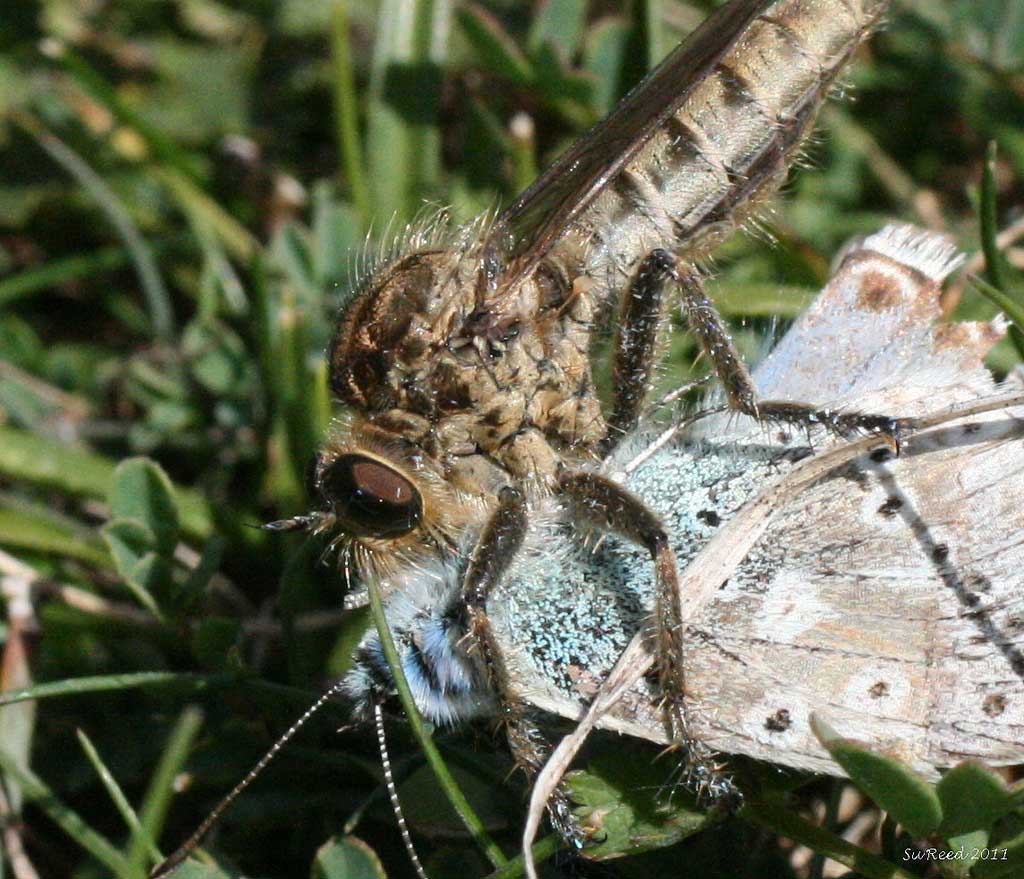 |
3
August 2011
 A
slow amble over the middle slopes of Mill Hill in the post
midday sunshine (22.8
°C) saw me venture in glades and thorn
off my usual path, noting that Kidney Vetch
was frequently seen in a small area (south of the Triangle)
when only occasional
flowers had been
seen before. It was amongst abundant Wild
Basil and clumps of Marjoram
and this area attracted four male Chalkhill
Blues and a pair of courting second brood
Dingy
Skippers (of five seen in under an hour).
A Chalkhill Blue
was noted visiting Plantain
and Wild Basil.
Common
Blues were the most frequent butterfly
with over 70 blue males seen. Other butterflies
were frequent
Meadow
Browns,
Gatekeepers
and
Small
Heaths, a few Large
Whites, a few Wall
Browns, one Peacock,
one Comma,
and a few Six-spotted Burnet Moths.
Under the shade there were frequent Speckled
Woods.
A
slow amble over the middle slopes of Mill Hill in the post
midday sunshine (22.8
°C) saw me venture in glades and thorn
off my usual path, noting that Kidney Vetch
was frequently seen in a small area (south of the Triangle)
when only occasional
flowers had been
seen before. It was amongst abundant Wild
Basil and clumps of Marjoram
and this area attracted four male Chalkhill
Blues and a pair of courting second brood
Dingy
Skippers (of five seen in under an hour).
A Chalkhill Blue
was noted visiting Plantain
and Wild Basil.
Common
Blues were the most frequent butterfly
with over 70 blue males seen. Other butterflies
were frequent
Meadow
Browns,
Gatekeepers
and
Small
Heaths, a few Large
Whites, a few Wall
Browns, one Peacock,
one Comma,
and a few Six-spotted Burnet Moths.
Under the shade there were frequent Speckled
Woods.
The
meadow north of the car park (which was usually so good for Common
Blues) was now invaded by Brambles
and a Common Ink Cap
mushroom grew from a dried out cow pat (which should have degraded months
ago).
Unusually,
I rapidly (>15 minutes)
traversed the transect acre
of the lower slopes, counting 42 Chalkhill
Blues (just one
female) two male Adonis Blues,
one Marbled White,
and the usual Common Blues, Meadow
Browns,
Gatekeepers,
Small Heaths and one Treble-bar
Moth.
Adur
Butterfly & Moth List 2011
1
August 2011
As
I was not happy with my one acre transect
count on Mill Hill the previous day, I went to the lower slopes and made
a fresh count in very good conditions (humid, weak sunshine, 20.2
°C, ESE Force 4)
and in the 20 minutes (timed)
it took me to amble along the transect, I counted 58 Chalkhill
Blues
(including
six females). The count included one mating
pair. Although this has been typical of the
last couple of years, it was only a tenth the total of a good year and
below par even for poor years. The first of
three second brood male Adonis Blues
showed, and without trying half a dozen second brood Dingy
Skippers, including courting pairs, fluttered
into view. This was more that usual years
when only a few are seen.
There were the expected frequent Meadow Browns, Gatekeepers, Common Blues and Small Heaths, a few Large Whites and one yellow Brimstone Butterfly. I sat down above the winding path (the transect are is south of the path) and watched a further 20 Chalkhill Blues including a mating pair that flew close enough to be photographed. Amongst the Brambles next to the path at the northern end of the lower slopes there was an unidentified butterfly that could conceivably have been a Brown Hairstreak.
I returned
by the quickest ridge route and noted on the top part of the hill two male
Chalkhill
Blues, enough Common
Blues to indicate they must be common in the
top meadows. A Wall Brown
fluttered over me. A Brown
Argus
on
the southern part of the Mill Hill was unusual in the location it was spotted.
Eleven
species
Adur
Butterfly & Moth List 2011
The
first Clouded Yellow of
the year was seen patrolling the bottom slopes of Mill
Hill right by the boundary hedge and was one
of 19 species
in the afternoon
including 60 Chalkhill Blues,
six Adonis Blues
and five Wall Browns.
Full
Report
Adur
Butterflies: First Dates
31
July 2011
At
the usual peak date for Chalkhill Blues
on Mill Hill I went directly to the lower
slopes in the late morning arriving on the slopes at 11:15
am and although a male Chalkhill
Blue appeared immediately at the southern
end, butterflies
were
frequently seen but
not common. In the next 25
minutes I ambled along the one
acre transect, I disturbed 33 male and four
female Chalkhill Blues,
two Small Heaths,
occasional
Meadow
Browns,
Gatekeepers,
and Large
Whites, four Common
Blues,
and a Wall Brown.
I sat down for 15 minutes (timed)
and when I looked around I noted a further 25 male Chalkhill
Blues in flight. When I got up and moved around
I noted 35 male Chalkhill Blues,
and most of these appeared fresh and could have just emerged. This
was a poor total of 72 Chalkhill
Blues
on
the lower slopes.
A
further eight Small Heaths,
more Common
Blues
were also seen,
and
without making more than a cursory attempt to search, I discovered at least
half a dozen second brood Dingy Skippers,
five on the lower slopes of Mill Hill, and one whilst looking for a Brown
Argus
on the middle slopes in the the Triangle area
amongst the Wild Basil.
There could have easily been more. The scrub and copse added six Speckled
Woods and a Peacock
Butterfly. The middle slopes also added
frequent Meadow
Browns,
a
female Chalkhill Blue, a female Common Blue
and
a few Six-spotted Burnet Moths and
another Wall Brown.
The top meadows added a Brimstone,
a Brown Argus,
and frequent Common Blues.
There
was a male Chalkhill Blue
on the Old Erringham pasture.
Summary
Butterfly Report
Small Scabious was seen on the lower slopes of Mill Hill, and Autumn Gentian was very common on the middle slopes and upper part of the hill. I saw my first Round-headed Rampion of the year in flower on the upper plateau.
28
July 2011
A
targeted search of the slopes and upper glades of Mill
Hill produced 12 Dingy
Skippers, this being by far the strongest
second brood showing I have ever seen. The knock-on effects of the unusually
warm spring may yet produce more unexpected events in the late summer and
autumn butterfly calendar.
 27
July 2011
27
July 2011
Approaching
would should be the peak period for the Chalkhill
Blues on Mill Hill with hundreds, perhaps
thousands fluttering around, it was dire that I only saw a fleeting view
of one male in half an hour on the one acre
transect. It was cloudy and there was a low
frequency of any butterflies
about on the lower slopes around midday
and these had to be disturbed. On and over the lower slopes there were
frequent white butterflies probably Large
Whites, 3+ Meadow
Browns,
3+
Gatekeepers,
2+ Red Admirals,
one Marbled White,
1+ Speckled
Woods, four Common
Blues
(two
of each gender), a probable Brimstone Butterfly,
one Treble-bar Moth and
frequent pyralid
moths
Pyrausta nigrata and at least one
Pyrausta
purpuralis. It was so disappointing,
that I quickly left by the quickest ridge route where I encountered a definite
Brimstone
Butterfly, one Wall
Brown, 2+ Gatekeepers,
on the vegetated path, and another male Common
Blue and Meadow
Brown
on the meadows south of the Reservoir.
Adur
Butterfly & Moth List 2011
24
July 2011
 Occasionally
the sun shone through the gaps in the clouds, but
it was too cool for most butterflies.
It was a few minutes before I spotted my first butterfly
on the lower slopes (descending from the south): a second brood Wall
Brown briefly visited a Violet.
Perhaps, the most notable observation were six Brimstone
Butterflies, three of each gender over
the central area of Wild Basil and
St.
John's Wort. In the transect
acre, I disturbed just nine male Chalkhill
Blues as the sun had gone behind the clouds,
with at least three Meadow Browns,
one Gatekeeper,
two Large Whites,
one Comma,
and at least one pyralid
moth
Pyrausta nigrata amongst the jumping
grasshoppers.
In the Hawthorn scrub, I noted a few Speckled
Woods and a larger than normal Red
Admiral settled.
Occasionally
the sun shone through the gaps in the clouds, but
it was too cool for most butterflies.
It was a few minutes before I spotted my first butterfly
on the lower slopes (descending from the south): a second brood Wall
Brown briefly visited a Violet.
Perhaps, the most notable observation were six Brimstone
Butterflies, three of each gender over
the central area of Wild Basil and
St.
John's Wort. In the transect
acre, I disturbed just nine male Chalkhill
Blues as the sun had gone behind the clouds,
with at least three Meadow Browns,
one Gatekeeper,
two Large Whites,
one Comma,
and at least one pyralid
moth
Pyrausta nigrata amongst the jumping
grasshoppers.
In the Hawthorn scrub, I noted a few Speckled
Woods and a larger than normal Red
Admiral settled.
By
the time I reached the middle slopes of Mill
Hill about 1:00 pm,
there was a rising flock of twenty Rooks
and a large black cloud over Erringham Hill. I heard a Skylark
sing but I could not see the bird, only a House Martin and a Magpie.
Typically, flitting from one stem head to another my first pristine Brown
Argus
of the year showed amongst the Marjoram
to the north of the Triangle area of the middle
slopes of Mill Hill Nature Reserve. It was
accompanied by a fresh male Common Blue.
The top part of Mill Hill was now very scrubby and as I hurriedly crossed
there were very few butterflies: a Large White,
nine Gatekeepers
(five around one Ragwort
flower), six Meadow Browns
and
a Speckled Wood.
I noted that Ragwort was
more frequently seen than in previous years on the southern part of Mill
Hill.
Summary
Butterfly Report
|
|
22
July 2011
I
headed off to Mill Hill
to get my weekly butterfly transect done while the sun was shining. More
Chalkhill
Blues emerged, including some large specimens.
There was a second brood of Adonis Blue.
A big surprise was second brood
Dingy Skippers.
I also saw a Grass Snake
slither away into the Brambles.
The
count was 5 Adonis Blue,
1 Brimstone,
1 Brown Argus,
9 Chalkhill Blue,
1 Comma,
1 Common Blue, 2 Dingy Skipper,
6 Gatekeeper,
1 Large White,
2 Marbled White,
7 Meadow Brown,
8 Peacock,
7 Red Admiral,
2 Small Heath,
4 Wall Brown.
15
July 2011
A
blue sky but a rather cool day for July,
19.2
°C at
midday:
so this meant the blue butterflies
were not actively flying. On the lower slopes of Mill
Hill, Gatekeepers
were frequent (over 40) and amorously lively, just two male Chalkhill
Blues were disturbed, and there were two
definite male Common Blues
which looked appreciably smaller, one resting Treble-bar
Moth, a few Meadow
Browns,
one Marbled
White, and four Peacock
Butterflies.
I
returned by one of the quicker routes noting only more Gatekeepers.
Adur
Butterfly & Moth List 2011
 10
July 2011
10
July 2011
On
a cloudy day, the first male Chalkhill
Blue Butterfly of the year flew about
quickly, noted only landing briefly on the yellow flowers of Bird's
Foot Trefoil and hiding amongst the leaves
of Horseshoe Vetch, on the lower slopes of Mill
Hill, There were occasionally
other butterflies:
occasional Gatekeepers, Large
Whites, and Green-veined
Whites, one Red
Admiral, a few Meadow
Browns,
one flying Burnet Moth,
a few Yellow Shell Moths
and one Brimstone Butterfly.
I
only visited the lower slopes. The yellow
of
Hawkbit, Bird's Foot Trefoil and
Yellow
Wort covered the slopes.
Adur
Butterflies: First Dates
Full
Butterfly Report
4 July
2011
On
a very pleasant sunny day (18.0 °C)
with a slight breeze, on the lower slopes
of Mill Hill, there was no sign of the first Chalkhill
Blues, just the occasional
Marbled Whites, frequent Small
Heaths and
Meadow
Browns.
The
three pyralid moths
were also seen: Pyrausta nigrata,
Pyrausta
purpuralis and
Pyrausta
despicata.
Stemless
Thistle were beginning to flower
and their prickly leaves could be felt when sitting down.
2 July
2011
It
has still not warmed up with the air temperature only reaching 17.3
°C at 1:00
pm feeling warmer when the sun pierced the
cloud cover. And on the lower slope of Mill
Hill, the first Chalkhill
Blue was yet to appear (the first one had
been seen elsewhere in Sussex).
There
were frequent
Marbled White Butterflies (including a
mating pair), frequent Small Heaths,
occasional
Meadow
Browns,
occasional Large Whites and one worn
Peacock
Butterfly on the lower slopes. In the
scrub there was frequent Meadow
Browns,
occasional
fresh Red Admirals,
occasional Gatekeepers
and
at least three Comma Butterflies.
On the top of the hill, there were a few more Small
Heaths,
Red Admirals,
Marbled
Whites and Large
Whites.
The
lower slopes were covered in yellow flowers which I think were mostly Lesser
Hawkbit. Grasshoppers
were stridulating loudly and constantly.
Full
Butterfly Report
30
June 2011
On
an overcast afternoon, I visited Mill Hill in the off-chance that I would
see my first Chalkhill Blue
recorded in June
(as the indicator flowers were about
one week earlier than 2010).
None were seen and as an aside, I did note six Marbled
Whites, two Small
Heaths, two Meadow
Browns
and
a few Large Whites on
the lower slopes. There were also pyralid
moths
seen occasionally flitting
over the herbage, with Pyrausta despicata
occasionally
seen and at least one
Pyrausta nigrata.
My first of the year Cinnabar Moth
caterpillar was seen on a budding Ragwort
plant.
Violets
with purple spurs
and rounded sepals (thought to be Sweet
Violets) were occasionally seen on the
southern end of the lower slopes as well a frequent Dog
Violets. Squinancywort was
seen for the first time this year. The frequent Musk
Thistles on the cleared scrub area was
a particular attraction for the Marbled Whites.
A Common Inkcap
(fungus) was seen next to a dried cow pat.
27
June 2011
On
a hot and humid morning, the lower slopes
of Mill Hill hosted 15+ Marbled White Butterflies,
12+
Small
Heaths, two Large
Whites, at least four Meadow
Browns,
one Comma, one
Burnet
Moth and two Red
Admirals (the latter at the southern steps).
I only visited the lower slopes, but on the southern part of Mill Hill
there were two more Marbled Whites,
another Small Heath,
a Yellow Shell Moth
and a Cinnabar Moth.
There
were more sightings of Marbled Whites,
but these were excluded as they were thought to be the same butterfly seen
twice.
A
new blooming of violets made their regular appearance
in summer but there is a puzzle over which species they are, with pointed
sepals (like the Dog Violet)
and a whitish-purple spur (with a shape like that of a Sweet
Violet). On the cleared land north of
the path on the lower slopes, Great Mullein
was frequent, with Musk Thistle,
and Perforate St. John's Wort all
flowering.
Adur
Violets
 24
June 2011
24
June 2011
On
an overcast day, the sun shone briefly and the breeze was still a Force
5.
Predictably,
butterflies
were hiding. A Red Admiral
rose from the southern part of Mill Hill.
On the wind swept lower slopes, I recorded nine Small
Heaths, two Meadow
Browns,
one Marbled White and
a Common Blue.
In
the Hawthorn scrub, there was a Large White,
two Meadow
Browns
and
a
Comma.
Battered by gusts on the top another Large
White, another Marbled
White and a Yellow
Shell Moth showed.
 |
 |

|
|
|
|
|
|
Parasitic
plants
were very much in evidence on Mill Hill,
with Common Broomrape*, Orobanche
minor, (? ID ?) added to my local
flora
list, as well as Yellow Rattle,
Red
Bartsia and Eyebright.
Other new flowers included Centaury,
Meadow
Cranesbill,
Field
Scabious and
Melilot
(species
not identified). Yellow Wort
was partially opened despite the cloudy conditions and frequently seen
in flower on the lower slopes. Smooth Sow-thistle,
Sonchus
oleraceus, was seen under the top
copse.
(*
In 2012, Brianne
Reeve suggested this was Knapweed
Broomrape, Orobanche
elatior.)
Butterfly
Report
21
June 2011
I
finally found a sunny window in the morning to do my weekly butterfly
transect at
Mill
Hill with the following result: two Common
Blue females, two Green-veined
White, one Large
Skipper, three Marbled
White, four Meadow
Brown,
seven
Small Heath,
one Small Tortoiseshell,
and one Small White.
It
was interesting to watch a Buzzard
soaring overhead carrying a Pheasant
and a Kestrel
looking for its next meal. There were many Pyramidal
Orchids in flower.
18
June 2011
Blown
up the downs by a WSW Force
6 Strong Breeze (28 mph) gusting to Fresh
Gale (Force 8) which nearly blew me
off my feet, the conditions were far from
optimum for butterflies
and I would not have been surprised if I had not seen any at all. The
original intention was see the Bee Orchids
on the verge at the bottom of Mill Hill Road but they were not present.
However,
the wind behind me was so strong that it was not a struggle to ascend the
hill by the road. Wild Thyme
was notable on the lower slopes of Mill Hill and this may have also attracted
a good condition Small Tortoiseshell Butterfly.
It flew away because I was there. The first of two Yellow
Shell Moths on the transect
flew amongst the Brambles.
Small
Heath Butterflies were amorous with 15
counted and ten on them seen simultaneously in the middle of the lower
slopes beneath the path. It was here I saw my only
Marbled
White Butterfly and my first of the year.
Pyralid
moths
were occasionally seen
flitting over the herbage, with Pyrausta
nigrata, Pyrausta pupuralis and
Pyrausta
despicata definitely identified. Grasshoppers
were common. Bird's Foot Trefoil
was noted but the Horseshoe Vetch,
Hippocrepis
comosa,
flowers
had now disappeared; their curly brown seed pods could still be seen amongst
the prostrate ground flora.
 |
A
Robin's
Pin Cushion
on Bramble with Perforate St. John's Wort. |
A Robin's
Pin Cushion was seen on a Bramble.
The Magpies
were making a lot of noise and these may have been newly fledged youngsters.
I returned by the ridge route because of the adverse weather conditions
and noted five more Yellow Shell Moths.
Adur
Butterfly & Moth List 2011
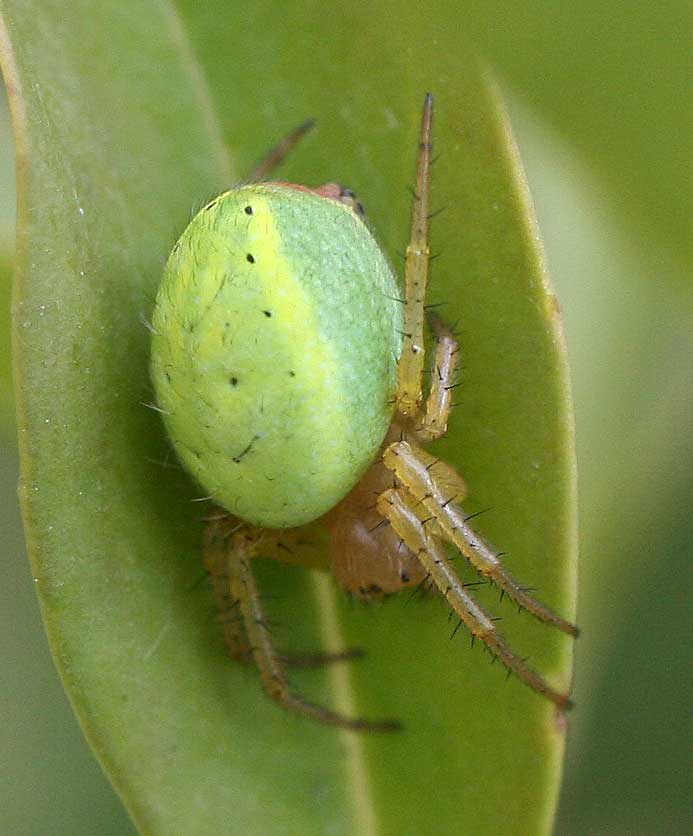 |
11
June 2011
Cucumber Spider, Araniella cucurbitina, on Mill Hill. Adur Spiders At Mill Hill, I saw and photographed my first Marbled White Butterfly of the year. I also spotted a Common Heath Moth, Ematurga atomaria. Adur Butterflies: First Dates |
31
May 2011
Swallows
are coming in. I saw my first of the year against the cloudy sky and later
four of them swooped low over the top of Mill Hill as I felt the first
drops of rain. A female Pheasant
whirred from what used to be a meadow and is now a bramble-covered temporary
pasture. Despite the poor conditions there were still butterflies
on the lower slopes of the hill, with 14 shredded and tatty Adonis
Blues
(with
two good condition females)
disturbed, and a probable Meadow Brown
which
I am satisfied it was my first of the year and the first one I have seen
personally in the month of May.
Eight
Small Heaths
were seen on the transect
and a pristine Small Tortoiseshell.
By the time I reached the Hawthorn scrub and middles slopes I hurried in
the intermittent drizzle and did not see any more butterflies. There was
lots of bird song with Wrens
chittering amongst the small trunks of Hawthorn. Yellow
Wort was seen in flower
for the first time this year on the lower slopes, the first yellow Great
Mullein flower on the southern steps to
the lower slopes, and the first flowering
Musk
Thistle on the brim of the ridge near
the Reservoir. On the southern part of Mill Hill, a single Yellow
Rattle was showing its first flowers.
Full
Butterfly Report
Adur
Butterflies: First Dates
|
|
20
May 2011
The
first
butterfly
of the day was a male Common Blue
on the southern part of Mill Hill. A weak sun shone through the clouds
for the 20 minutes it took me to complete the
1.2 acre transect on the lower slopes of Mill
Hill recording 46 Adonis Blues
(including
seven females
and one pair attempting to mate), four Small
Heaths, one male Brimstone
Butterfly, one confirmed Large
White as it settled on a Horseshoe
Vetch,
Hippocrepis comosa,
flower,
one tattered Peacock Butterfly,
and
one Green Hairstreak.
All the butterflies were reasonably lively
in the afternoon, buffeted by a Force
5 from the south-west, and there were
a handful more Adonis Blues
off transect. There was a Wall Brown
and two Speckled Woods
in the Hawthorn scrub, where I heard a pair of Chiffchaffs
singing
before I saw one of the small birds fly up into the low thorn canopy. Two
more Adonis Blues
fluttered over the Horseshoe Vetch
on the middle slopes Triangle area, but the
sun had gone behind the cloud by I had reached the top of the hill and
all the butterflies were now hidden, although I caught sight of another
Peacock
before it disappeared under a Bramble leaf.
Full
Butterfly Report
 16
May 2011
16
May 2011
Because
I omitted to visit the upper part of Mill Hill the previous
day, I trekked up in identical cool and
breezy conditions and wandered over the middle slopes and the former meadows
near the top car park and recorded 37 Common
Blue
Butterflies
(33 males 4 females), my first
Cinnabar
Moth of the year, one Small
Heath Butterfly, a flying Wall
Brown, two
Speckled
Yellow Moths and a few of the tiny
pyralid
moths
Pyrausta nigrata.
Sea
Campion was noted by a path at the northern
extreme of Mill Hill Nature Reserve. In contrast
to the lower slopes the amount of Horseshoe
Vetch,
Hippocrepis comosa,
in the Triangle are of the middle slopes was
as luxurious as usual and even on the top plateau (south of the upper car
park) the swathes were much better than 2010.
Eyebright
poked their pretty little flowers up
from a clump of Bird's Foot Trefoil leaves on an ant's mound in
the Triangle middle slopes of Mill Hill. On the top of Mill Hill, a single
Greater
Knapweed
was in almost full flower, and
amongst the Brambles
I saw a Greater Bird's Foot Trefoil
in flower. (I omitted to visit the lower
slopes and Hawthorn scrub.)
Adur
Butterfly & Moth List 2011
15
May 2011
On
a cool (>15.1 °C)
cloudy day I visited Mill Hill
and despite being buffeted about by a WNW
Moderate Breeze (Force
4) the first
butterflies
to attract my attention were a couple of courting Holly
Blues by a hedge to the south-west of
the bridge over the A27
(top of the Pixie Path). On the southern part
of Mill Hill, a handful of new male Common
Blue Butterflies were the first I had
seen this year. Going to to the steps to the lower slopes from the southern
end, the north-westerly direction of the wind made conditions poor for
butterflies on the exposed slope. Almost all of them were hiding or resting,
and on the 1.2 acre transect
I disturbed exactly 100 Adonis Blues
(88 males and 12 females) in 25 minutes. None of them was flying until
I arrived. One Small Heath
was seen out of the corner of my eye, one Green-veined
White was actively fluttering around but
disappeared for five minutes, and the five Dingy
Skippers were seen in flight, three of
them at eye level. I also disturbed two Yellow
Shell Moths and one Treble-bar
Moth. There were occasional micro-moths
but none of the normal pyralids
were observed. Because of energy sapping wind and the first spots of rain
I did not wander around Mill Hill as usual but remained on the lower slopes
for half an hour noting almost as many more (estimated 60 more seen) Adonis
Blues
on
the steeper slopes above the winding path, including 15 more females, two
courting pairs, but none of them were seen mating. Two females seem to
discourage the amorous advances of the now worn and damaged blue males
and crawled over the leaves of Horseshoe Vetch looking to lay their
eggs. Small
grasshoppers were frequently
seen and they were heard stridulating. Occasional Honey
Bees visited the Horseshoe
Vetch, their weight folding the small flowers
over.
Adur
Butterfly List 2011
723.jpg) |
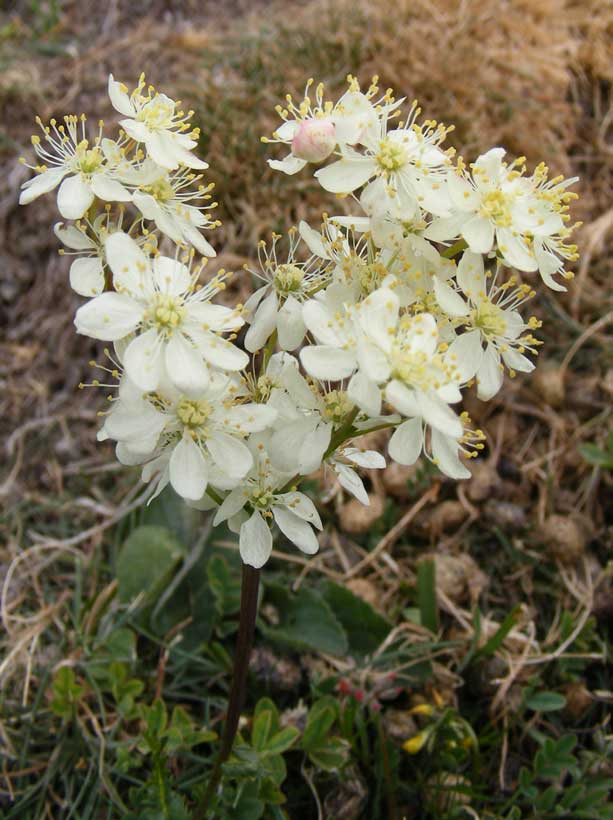 |
 |
 |
|
|
|
|
|
This year the expanse of Horseshoe Vetch, Hippocrepis comosa, on the lower slopes was extremely disappointing. It was already past its prime and the flowers were only showing about 20% of their usual brilliance after an extended dry spring. The spiral horseshoe seed pods were commonly seen. On the lower slopes the first Dropwort was seen in flower, there was still frequent Dog Violets and the inevitable Milkwort, and the miniature Fairy Flax with their flowers closed in the cool overcast conditions. A flowering Dogwood was also seen on the lower slopes. The first Lesser Hawkbit, Leontodon taraxacoides, of the year, was seen near to the gate to the Old Erringham pasture. On the edge of Mill Hill Road, Sea Campion was noted for the first time in Mill Hill Nature Reserve. Fumitory was almost about to flower and this delicate plant was hidden in the undergrowth by the path as it winds its way through the Hawthorn at the northern end of the lower slopes.
Horseshoe
Vetch starts flowering in middle to late April, peaks in mid-May, continues
in profusion for about a week and is usually all over by the first week
in June.
Flowering
Dates of Horseshoe Vetch
It
is surmised that the failure of the flowering Horseshoe
Vetch,
Hippocrepis comosa,
on the shallow soil lower slopes of Mill Hill
was because of the driest Spring on record.
Met
Office Rainfall Statistics for the Spring of 2011
13
May 2011
I
visited Mill Hill
to do my weekly butterfly transect. It was a warm day with cloud and sun
pushing through and I recorded: 182 Adonis
Blues,
two
Brimstone Butterflies,
six Dingy Skipper,
four Green Hairstreak,
two Grizzled Skipper,
three Holly Blues,
and two Large Whites.
The
Adonis Blues
were mating all over the lower part of the hill.
10
May 2011
We
had an evening stroll after work up to Mill
Hill, Shoreham, to see what delights awaited
us. We were not disappointed. We found one Dingy
Skipper, two Grizzled
Skipper, two Cinnabar
Moths (the first of the year), about ten
Small
Heath and about fifty Adonis
Blues.
8
May 2011
On
a cool (13.6 °C)
and cloudy day, there was a Gentle Breeze (Force
3) but no gaps in the clouds for the sun
to shine. There was just one Dingy
Skipper seen in active flight on the lower
slopes of Mill Hill, but I disturbed 41 male Adonis
Blues in 20 minutes, invisible amongst
the Horseshoe
Vetch,
Hippocrepis comosa,
until I almost trod on them and I also spotted seven more resting with
their wings open before fluttering off at my approach. Previous estimates
that in these conditions that there will be three times as many Adonis
Blues
resting and unseen and one male Adonis Blue
was seen resting with its wings closed unusually on a small Privet
and it was not about to fly away even if approached to 100 mm with a camera.
So
on the 1.2 acre transect the estimate (3 x 41 + 7=) was 130 Adonis
Blues extrapolated over the five acres by
three times to 390 on Mill Hill. The first
glimpse of fluttering on the lower slopes was my first of the year
Yellow
Shell Moth, and first of two seen, and
also one of the Treble-bar Moths.
After it began to spit with rain, I avoided the scrub and wandered over
the middle slopes where I notes my first two Silver
Y Moths of the year. I disturbed a Peacock
Butterfly on the southern part of Mill
Hill on the verges of the road.
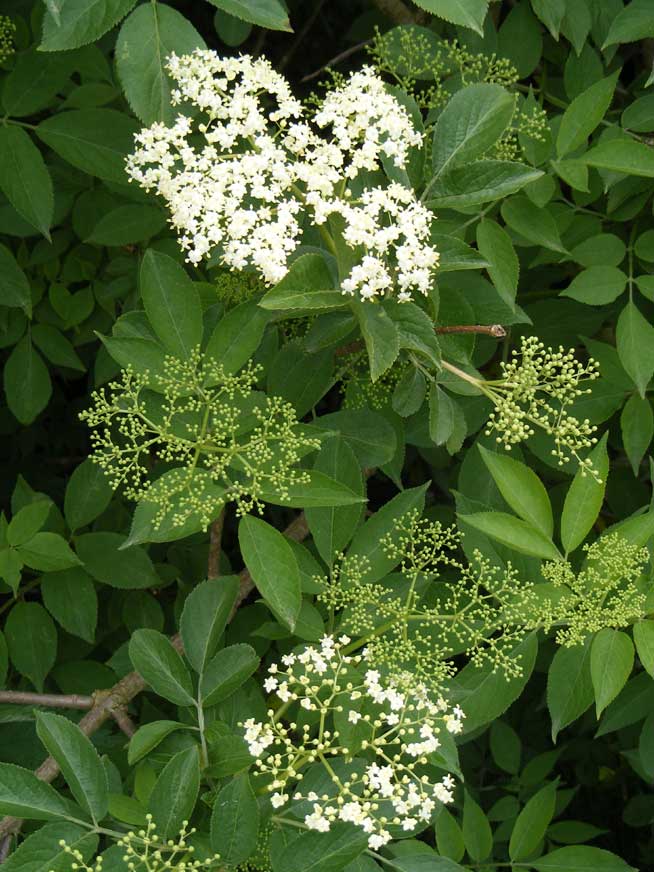 |
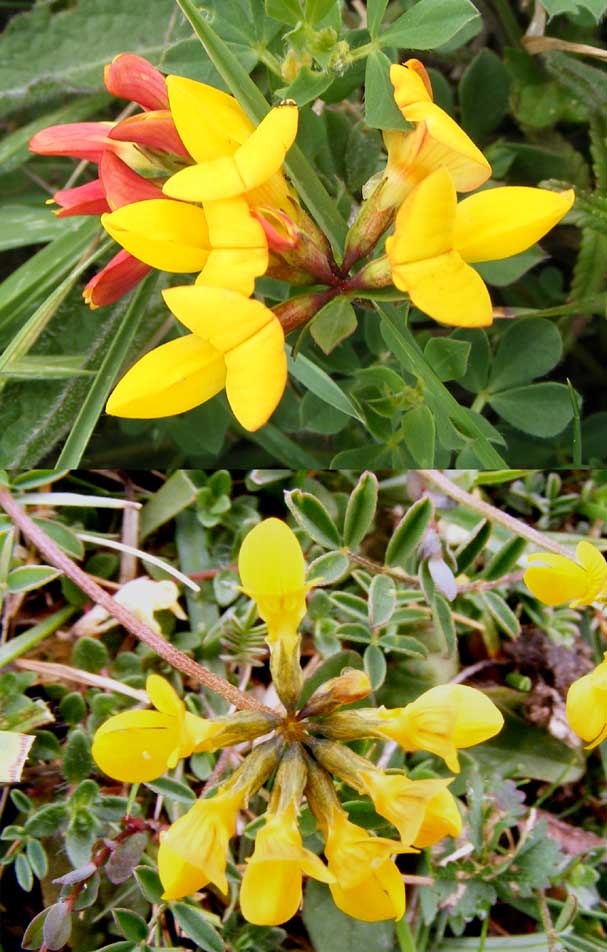 |
 |
 |
|
|
Horseshoe Vetch |
|
|
Horseshoe
Vetch,
Hippocrepis comosa,
was abundant on the lower slopes of Mill Hill, but at a few days away from
its full bloom. There were also small amounts on the middle slopes (the
Triangle)
and on the plateau to the south of the upper car park. The amount on the
plateau was much less than before the cattle grazing and included the occasional
Bird's
Foot Trefoil, the first area on the hill
in which this plant was seen in flower. There were still dried cow pats
all over the place and they were a great nuisance. On the ridge by a warren
of Rabbit burrows,
Elderberry
was
beginning to flower.
White Campion was
in flower near the Reservoir on Mill Hill. Dropwort
was budding on the lower slopes.
Flowering
Dates of Horseshoe Vetch
7 May
2011
I
did my weekly transect at Mill Hill
in the morning and counted 1 Holly Blue,
2 Brimstone Butterflies,
7 Small Heath,
23 Dingy Skipper,
112 Adonis Blue.
Most of these were at the bottom of the hill, though I did see Dingy
Skippers and Adonis
Blue by the top car park. The hill was covered
by Horseshoe Vetch,
Hippocrepis
comosa, and
I saw a Green Hairstreak,
2 Small Coppers,
2 Grizzled Skippers
and a Red Admiral.
1
May 2011
On
a
cool breezy day,
the Adonis Blues
were emerging from the herbs as I strolled along my 1.2
acre transect on the lower slopes of Mill
Hill. In 25 minutes
I recorded 31 (including four females) and as I waited about eight minutes
for the Small Copper
to appear, another nine fluttered by. The other butterflies
recorded on the transect were one male Orange-tip,
six Brimstones,
21 Dingy Skippers,
eight Grizzled Skippers,
six
Green-veined Whites,
two Green Hairstreaks (the most I have seen in a day), three Peacocks,
five Small Heaths,
and two Wall Browns at
the southern end. A half a dozen Treble-bar
Moths were counted, some of them hiding
amongst the new growths of Privet. On the rest of Mill Hill, I recorded
four Holly Blues,
two more Dingy Skippers,
two strong flying Brimstones,
two more Wall Browns
leaving Mill Hill and fluttering over Old Erringham pasture, five Speckled
Woods in amongst the Hawthorn,
a courting pair of Adonis Blues,
two Green-veined Whites
that obliged me by remaining still for a few seconds each, and one Red
Admiral.
Fourteen
butterfly species on Mill Hill
Adur
Butterfly List 2011
 |
345.jpg) |
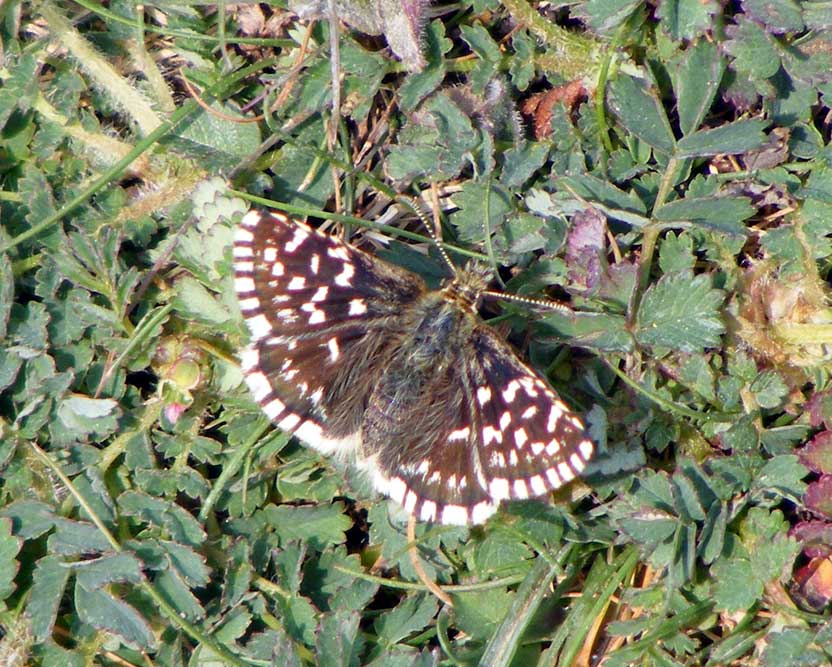 |
|
|
|
|
A female Beautiful Demoiselle, Calopteryx virgo, (a damselfly) fluttered like a butterfly over the Brambles south of the Copse at the top of Mill Hill Nature Reserve.
29
April 2011
My
first of a handful of male Adonis Blues
were seen this year on the lower slopes of Mill Hill, together with my
first of frequent Small Heaths,
my first dainty Small Copper
at the northern end of the lower slopes, my second Green Hairstreak
of the year on Brambles in the same area, 27+ Dingy
Skippers, two Grizzled
Skippers and a notable record of Brimstone
Butterflies
mating. There were also occasional male Orange-tips,
a Wall Brown,
more Brimstones,
frequent Green-veined Whites,
occasional Large Whites,
Speckled
Woods and Holly
Blues on Mill Hill. A larger medium-sized
Treble-bar
Moth was noted.
 |
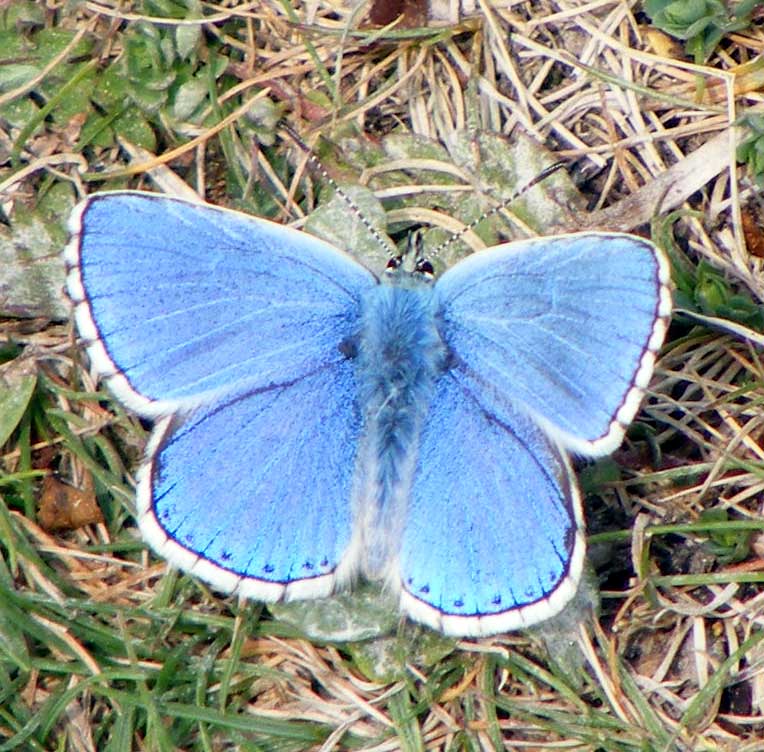 |
 |
 |
|
|
|
|
|
First
of the year flower
appearances noted were Bird's Foot Trefoil
on
the (now) pastures
of Mill Hill, NW of the upper car park,
and Hounds-tongue
on the lower slopes. A dozen Jackdaws
fossicked over the yellow carpet of Bulbous
Buttercups on the Old Erringham pasture.
On the lower slopes the flowers of Horseshoe
Vetch,
Hippocrepis comosa,
were abundant but at least a week (probably more) from showing like a carpet
of yellow. The first very small green-coloured
grasshoppers
were hopping around amongst the herbs a especially at the southern end
of the lower slopes where the Horseshoe Vetch
was making a comeback after the Privet
had been cleared. A female Broad-bodied
Chaser patrolled over the Brambles south
of the Copse
at the top of Mill Hill Nature Reserve in
the same area as three
days previously.
Full
Butterfly Report
Flowering
Dates of Horseshoe Vetch
Colin
Knight's Report of the Day (Link to Sussex Postcards)
26
April 2011
I
visited Mill Hill
in the afternoon and saw scores of Dingy
Skippers, on the lower slopes it seemed
as if there was one every few feet! Also a fair number of Grizzled
Skippers, Small
Heaths (including one mating pair) and
a few Brimstones
and Peacocks.
The male Adonis Blues
(first of the year) are just starting to emerge and I got a photo of a
nice pristine specimen. Also one Small
Copper (first of the year) and one Wall
Brown. But alas no Green
Hairstreaks!
|
|
On a breezy (Force 4 to 5) cool (>16.0 °C ) day, I made a quick visit to Mill Hill, with the west-facing lower slopes partially sheltered from the northerly wind. The Blackthorn had ceased and the Hawthorn was beginning to flower.
The scrub at the north-west end of Mill Hill Nature Reserve
A 30
minute walk over the 1.2 transect
on the lower slopes instantly produced the first of three Grizzled
Skippers, but most skippers
in flight were Dingy Skippers
with at least 25 and a few of these turned out to be Burnet
Companion Moths. There were thousands
of Horseshoe Vetch,
Hippocrepis
comosa, in flower on the lower slopes
but nothing like its peak occurrence. A large greenish-white female Brimstone
Butterfly visited Milkwort
which
had largely replaced the Dog Violets. Pyralid
moths
were occasionally seen
flitting over the herbage, with Pyrausta
nigrata and
Pyrausta
despicata definitely identified. Crane-flies,
Tipula,
were
mating.
 |
 |
 |
 |
|
|
|
|
|
An
early Wall Brown Butterfly
(my first of the year) was seen fluttering over the everlasting cow pats
of what was recently a wild flower meadow,
now a Bramble-covered pasture
on Mill Hill, NW of the upper car park. This was shortly followed by a
few Large Red Damselflies
and my first dragonfly
of the year which was a female Broad-bodied
Chaser flying over the Brambles.
A
Common
Carpet Moth was seen amongst Bramble on
the middle slopes. I returned a meandering route through the scrub and
grass of the middle area of Mill Hill without spotting anything of note.
Full
Butterfly Report
Adur
Butterflies: First Dates
24
April 2011
The
rarely recorded day-flying mico-moth
Elachista
biatomella was caught and identified
by Tony Davis
on Mill Hill and an evening moth trap caught 37 other species of moths
including four Barred Tooth-striped Moths.
Whilst trapping in the evening we were serenaded by a Nightingale
and
a Cetti's Warbler,
Cettia
cetti.
The
first Small Heath Butterfly of
the year was seen on Mill Hill.
The slope was covered in Dingy Skippers.
I spotted Brimstones,
Peacocks,
Orange-tips,
Large
Whites, a Speckled
Wood, and three Grizzled
Skippers. Two
Holly
Blues were seen in a woodland path at
the top. A
Burnet Companion Moth
was spotted. A Buzzard
patrolled overhead.
17
April 2011
Spring
arrived on a sunny day (14.5 °C)
visit to Mill Hill where the first flowers
of Horseshoe Vetch, Hippocrepis
comosa, appeared on the lower slopes
with another prostrate downland herb Milkwort.
All of the few Horseshoe Vetch flowers
and occasional Daisies
were covered in tiny black beetles
Meligethes,
and the slightly larger shiny
green beetle Cryptocephalus crawled amongst the vegetation.
By the path Germander Speedwell
was seen for the first time this year. Salad
Burnet was beginning to flower.
Flowering
Dates of Horseshoe Vetch
 |
 |
 |
|
|
|
|
Brimstone
Butterflies flew strongly over all parts
of Mill Hill, with 15 recorded of both genders. Peacock
Butterflies were similarly widespread
with at least six counted but I think there were more. On the lower slopes
the skippers
were occasionally seen
both Dingy Skippers (including
a courting pair) and Grizzly Skippers,
plus a Green-veined White.
A fluttering amongst the bramble on the middle part of Mill Hill was recognised
as the locally scarce Green
Hairstreak Butterfly. On the carpet of dried cattle excrement which
was once a meadow on the upper part of Mill Hill, I noted a Small
Tortoiseshell Butterfly. A strong buzzing
noise announced the arrival of a Bee-fly
to the expanse of Cowslips
at the northern end of the middle slopes. Unfortunately, it buzzed off
without resting its wings and I could not discern if was the common
species or the rarer Dotted
Bee-fly. The first of two Red-tailed
Bumblebees,
Bombus lapidarius,
disappeared into a small hole on the lower slopes of Mill Hill.
Full
Butterfly Report
Adur
Bumblebees 2011
12
April 2011
I
could not miss the chance to see the Adders,
Vipera
berus, and they were located*
on
the lower part of Mill Hill about mid-way along under the scrub at the
bottom (west) of the slopes. I saw four separate
Adders,
two were black, one was dark and another was almost silver with the black
triangles. I assume the writhings of the two Adders
were copulation.
I got within two metres of them without disturbing their mating embrace
under the Brambles,
which I observed through my binoculars. The silver one was the most
impressive as it slithered through the undergrowth.
 |
 |
 |
Adderation (by Colin Knight) Link
If you or someone else has been bitten by a snake, you should follow the advice outlined on the web page below and seek medical attention by visiting the nearest Accident and Emergency (A&E) Department or dialling 999 to request an ambulance if it is a medical emergency (shock).
 |
 |
 |
 |
|
|
|
|
|
I also
discovered the first of at least six Dingy
Skippers and at least nine Grizzled
Skippers, two Green-veined
White Butterflies, a few Peacock
Butterflies, and as I was leaving a male
Orange-tip
Butterfly made hurried visits to the abundant
Dog
Violets.
Pyralid
moths
were also frequently (30+ actually noted) seen
flitting over the herbage, with frequent Pyrausta
nigrata , a few Pyrausta
purpuralis, and Pyrausta
despicata definitely identified. The
tiny Violet Cosmet Moths,
Pancalia
leuwenhoekella,
were frequently seen
on Daisies. Occasional
Common
Bee-flies flitted around and although
they did not settle for positive identification, I think they were all
the common species. Cowslips
and Ground Ivy were
noted on the lower slopes. The
frequent dried cow pats were a considerable nuisance.
Full
Butterfly Report
Adur
Skippers
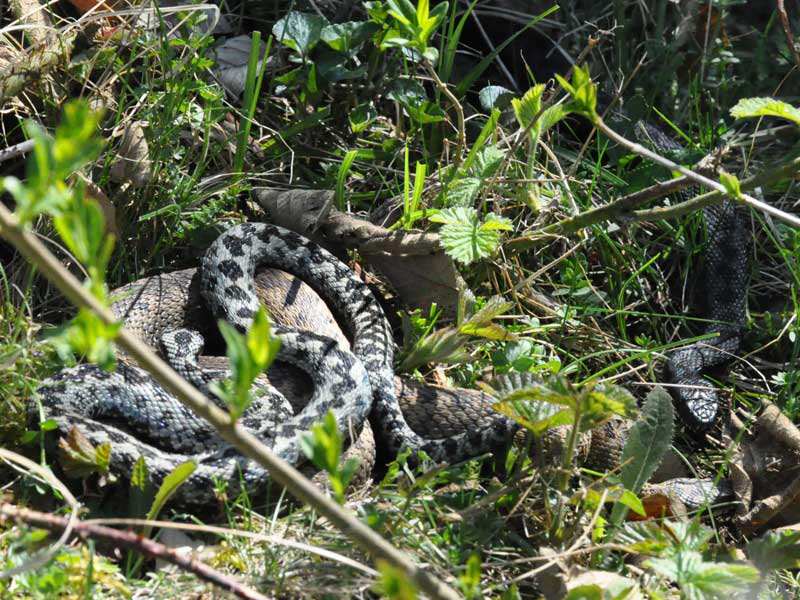 11
April 2011
11
April 2011
At
Mill Hill I was rewarded by a fantastic display by at least four Adders.
A large brown female was mating with a 'white' adder. A black
Adder then appeared but decided not to interfere.
The pair disappeared into the bushes, then two black
Adders twisted about each other while rearing
up to determine dominance. All this occurred in the same spot.
Two
Whitethroats
sang fiercely at each other at the top of the hill. There were just a few
Dingy
Skippers and 10 Grizzled
Skippers which were nectaring on Dandelions.
10
April 2011
I
called in at Mill Hill
to see what the butterflies were up to. John
was
already there, followed by Chris.
As there were quite a number of Dingy Skippers
in flight including pairs in aerial combat, I called Neil
Hulme. Richard, Dan and Cherie also arrived
to make for a 'flutter' of butterfly fanciers. A guy from Scotland completed
the party and we were able to show him both Dingy
and Grizzled Skippers.
Neil
reported that he had seen a pair of Adders,
Vipera
berus, together the previous day,
one a black Adder.
We came across the same pair plus another one.
9
April 2011
Mill
Hill showing the Blackthorn in bloom and
Common
Gulls in flight over the River
Adur
View
from the west
8 April
2011
In
April the extent of the Blackthorn
scrub on Mill Hill have be easily discerned by the patches of white flowers
before the Hawthorn blooms. Dog
Violets flowered in abundance
on the lower slopes bathed in a weak sunshine with some Sweet
Violets remaining. The Dog
Violets were in greater profusion than
the earlier Sweet Violets.
Top
Copse at Mill Hill showing the Blackthorn in bloom
View
from the south-east
 On
the lower slopes of Mill Hill, Peacock
Butterflies were frequent, with occasional
Brimstone
Butterflies, including a mating pair.
I nearly fell over my first Grizzled Skipper
visiting a Dandelion.
Colin
Knight spotted and photographed a Dingy
Skipper and this may be the first report
of this small butterfly in England this year.
Pyralid
moths
were also frequently (25+
actually noted) seen flitting over the herbage, with Pyrausta
nigrata and
Pyrausta
despicata definitely identified. The
tiny dark insects on Common Daisies
were Violet Cosmet Moths, Pancalia
leuwenhoekella. There were probably
scores of them, but I only noted a few. I only visited the lower slopes,
where I noted both a Crow
and a Rook
together (just passing each other) in the air above the ridge. Later, Colin
Knight reported a Burnet
Companion Moth. He also saw a Comma
on the upper part of the hill.
On
the lower slopes of Mill Hill, Peacock
Butterflies were frequent, with occasional
Brimstone
Butterflies, including a mating pair.
I nearly fell over my first Grizzled Skipper
visiting a Dandelion.
Colin
Knight spotted and photographed a Dingy
Skipper and this may be the first report
of this small butterfly in England this year.
Pyralid
moths
were also frequently (25+
actually noted) seen flitting over the herbage, with Pyrausta
nigrata and
Pyrausta
despicata definitely identified. The
tiny dark insects on Common Daisies
were Violet Cosmet Moths, Pancalia
leuwenhoekella. There were probably
scores of them, but I only noted a few. I only visited the lower slopes,
where I noted both a Crow
and a Rook
together (just passing each other) in the air above the ridge. Later, Colin
Knight reported a Burnet
Companion Moth. He also saw a Comma
on the upper part of the hill.
Skippers
on Mill Hill (by Colin Knight)
Adur
Skippers
Full
Butterfly Report
7 April
2011
I
was surprised by the number of Peacock
Butterflies we saw all over Mill
Hill, a total of 22. There was plenty of aerial
fisticuffs, including one bunch of five flying together in a ball. We had
a male and female Brimstone,
two Small Tortoiseshells
and one Grizzled Skipper
at the bottom of the hill at 1:45 pm.
Later I saw an Orange Tip
flying west to east at the bottom of the hill following the shrub line,
with two brief stops. A Buzzard
soared overhead and Whitethroats
were heard singing.
3
April 2011
 A
Kestrel
hovered over Mill Hill on an overcast day. The first glimpse of colour
and movement was a pristine Small Tortoiseshell
Butterfly, seen on straw on the southern
part of Mill Hill and at least two more were seen on the lower slopes,
again choosing straw as favoured landing spots. A few Peacock
Butterflies (at least two) visited Dog
Violets which were now the dominant species
with thousands of plants flowering on the lower slopes, all mixed
up with the remaining Sweet Violets.
A Brimstone Butterfly
skirted the hedgerow at the bottom of the lower slopes. The small Pyrausta
nigrata pyralid
micro-moths were frequently seen (about a dozen
actually observed) and one very faded Pyrausta
purpuralis. This was the earliest
in the year that they have been recorded. The yellow flowers were Dandelion
but their leaves could not be seen. A Common
Bee-Fly,
Bombylius
major, was also spotted amongst the Dog
Violets, which were also visited by Carder
Bees (bumblebees).
I
returned by the shortest ridge route. At least three spider
webs were only noticeable amongst the ground flora because they were covered
in dew.
A
Kestrel
hovered over Mill Hill on an overcast day. The first glimpse of colour
and movement was a pristine Small Tortoiseshell
Butterfly, seen on straw on the southern
part of Mill Hill and at least two more were seen on the lower slopes,
again choosing straw as favoured landing spots. A few Peacock
Butterflies (at least two) visited Dog
Violets which were now the dominant species
with thousands of plants flowering on the lower slopes, all mixed
up with the remaining Sweet Violets.
A Brimstone Butterfly
skirted the hedgerow at the bottom of the lower slopes. The small Pyrausta
nigrata pyralid
micro-moths were frequently seen (about a dozen
actually observed) and one very faded Pyrausta
purpuralis. This was the earliest
in the year that they have been recorded. The yellow flowers were Dandelion
but their leaves could not be seen. A Common
Bee-Fly,
Bombylius
major, was also spotted amongst the Dog
Violets, which were also visited by Carder
Bees (bumblebees).
I
returned by the shortest ridge route. At least three spider
webs were only noticeable amongst the ground flora because they were covered
in dew.
Adur
Violets
Moths
that feed on Dandelions
2 April
2011
On
Mill
Hill I found my first Grizzled
Skipper of the year, plus a couple of
Peacock
Butterflies.
29
March 2011
A
careful examination of the Pancalia
micro-moths on the lower slopes of Mill Hill
revealed
some (17) to be the Scarce Violet Cosmet, Pancalia
schwarzella, (ID confirmed by Tony
Davis, and the first Sussex records since 1931) rather than the common
species Violet Cosmet, Pancalia
leuwenhoekella. The latter species has a white band on its antennae.
The Easter Fox
Spider, Alopecosa
barbipes,
was also found.
I
also found a nationally scarce carabid beetle
Licinus depressus which
has specially adapted jaws to feed on snails.
25
March 2011
In
the evening we lugged a generator and MV trap down to the bottom of Mill
Hill to survey for Barred Tooth-stripe
Moth (BTS) and see what else was around. Although one Barred Tooth-stripe
flew to the light at 7:30,
this was the only one that the MV attracted this time, whereas on previous
visits good number have come to the trap. Between the trap and wandering
around with nets we managed to record 14 moth
species including 1 Oak Beauty, 8 Clouded Drab, 1 Red
Chestnut and a few micros including a very pretty one with raised scales
on its wings that we have tentatively identified as Acleris
cristana. In addition to the BTS that visited our trap we found
21 resting on Privet,
one resting on a grass stem and a final moth that landed on Penny
as we were walking back up to the car with the trap. If anyone else goes
to hunt for them, they were very obvious on the
Privet about 20 meters above the northern
end of the lower path, a couple of hours after sunset.
A
photograph showing the density of Sweet Violets on the lower slopes of
Mill Hill
visited
by a Brimstone Butterfly
The
volunteer workers seemed to have made a good job of the clearance, but,
alas, the Cattle
had been allowed to venture down below the path and had left frequent cow
pats drying in the sun. The southern part of the hill was appreciably shorn
of vegetation, but the upper meadows were so covered in cow pats that walking
through them would have been unpleasant. The Cattle had now been removed
from Mill Hill. A few Queen Buff-tailed
Bumblebees were seen.
Adur
Butterfly List 2011
Adur
Butterflies: First Dates
Adur
Butterfly Flight Times
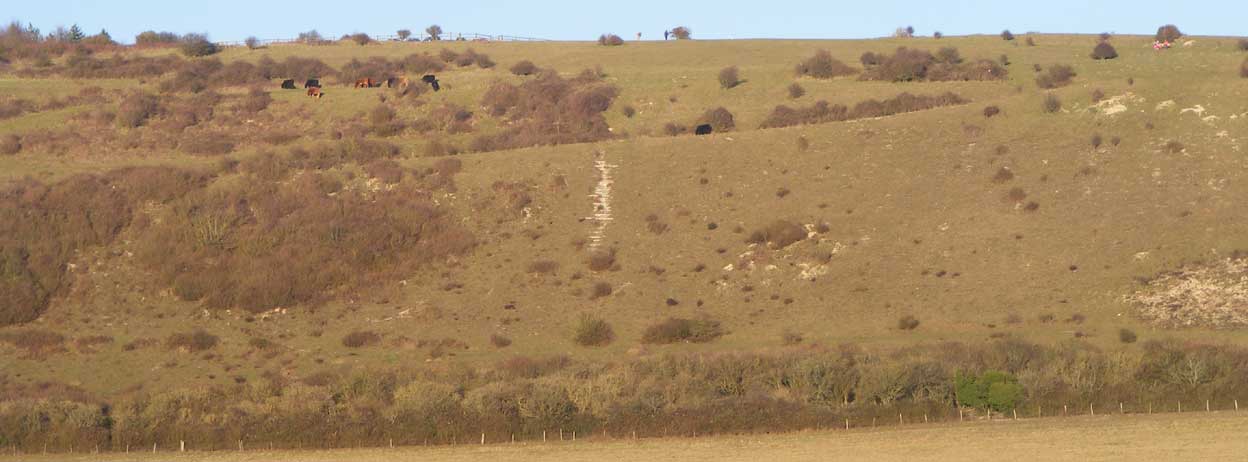
12
January 2011
Cattle
have
been introduced by the South Downs Conservation
Board* to the upper part of Mill Hill and a small herd were seen grazing
on the southern part of the Nature Reserve.
(* The South Downs National Park
Authority will become operational on 1
April 2011.)
7 January
2011
As
the first rays of sunshine of the year occurred for about an hour around
midday,
I
ventured to Mill Hill for the first time for over a month.
It was squelchy and very slippery on the path down to the lower slopes,
and as it levelled out the path contained a few puddles. Much of the Privet
below
(west of) the path had been cleared and much of this land was covered in
fallen leaves. No flowers were seen
apart from the dead heads of Carline Thistle.
 |
The cleared southern part of the lower slopes of Mill Hill as viewed from the northern part of the lower slopes. |
|
Moss
was
noted as prevalent on the lower slopes, but not exclusive to Mill Hill
and seen in the same amounts on the chalky grass roads verges in north
Shoreham. The return ridge route was much less slippery. Over a dozen Rooks
flew overhead.
Mill
Hill Wildlife Reports 2010 (Link)
Identification
of Grasses (Link)
Mill
Hill Grasses
|
|
|
|
|
|
|
|
|
18
SPECIES OF BUTTERFLIES DEPENDENT ON MILL HILL
FOR BREEDING:
(Estimated
numbers for Mill Hill Nature Reserve only
are in brackets)
| Chalkhill
Blue (3000 +)
Adonis Blue (50 -100) Dingy Skipper (75) |
Small
Heath (250)
Wall Brown (12) Meadow Brown (300) |
Marbled White (50)
Gatekeeper (200) Speckled Wood (>50) Green-veined White (2+) |
Common
Blue (>4000+)
Small Blue (5) Brimstone (8) |
Small
Skipper (>50)
Large Skipper (10+) Grizzled Skipper (20) Brown Argus (>30) Green Hairstreak ( a few) |
The other species may breed on Mill Hill, but there main breeding area will be adjoining fields or slightly further away. e.g. Small Blue (included above), Small Copper, Small Tortoiseshell, Green-veined White, Peacock, Ringlet, Small White, Large White, Comma, Holly Blue, Orange Tip. (=10)
The following are immigrants &/or hibernators: Red Admiral, Painted Lady, Clouded Yellow.
The following have not been positively identified (because of ID difficulties): Essex Skipper. This species is now included for a local field on the Adur Levels within 500 metres of Mill Hill.
(=30)
The
following was confirmed only in 2009:
Green
Hairstreak.
(=31)
The next one is no longer
found on Mill Hill but were there in the recent (reduced drastically to
almost extinct by 1948 last record in 1968) past: Dark
Green Fritillary (Records of this butterfly
in 1857, 1938, and 1945 when it was common.)
The next one is no longer
found on Mill Hill but were there in the distant (1947) past: Grayling.
The next one has been recorded
near Mill Hill in the middle distance past: White-letter
Hairstreak
(=34)
The
Silver-spotted
Skipper does not appear to ever have occurred
on Mill Hill
The
Silver-studded
Blue has never been recorded from Mill Hill
The Short-tailed Blue was recorded as a single immigrant in 1956.
17
August 2009
A
possible (unconfirmed) Brown Hairstreak Butterfly
was
spotted.
Aerial
Map
Lower
Adur Levels (MultiMap) including Lancing Clump and Mill Hill
Horseshoe
Vetch,
Hippocrepis comosa
First
Draft of the Article for the Shoreham Society Newsletter